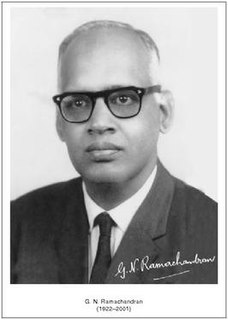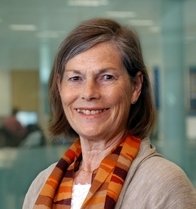
Sir John Cowdery Kendrew, was an English biochemist, crystallographer, and science administrator. Kendrew shared the 1962 Nobel Prize in Chemistry with Max Perutz, for their work at the Cavendish Laboratory to investigate the structure of heme-containing proteins.
Johann Deisenhofer is a German biochemist who, along with Hartmut Michel and Robert Huber, received the Nobel Prize for Chemistry in 1988 for their determination of the first crystal structure of an integral membrane protein, a membrane-bound complex of proteins and co-factors that is essential to photosynthesis.

Adolf Friedrich Johann Butenandt was a German biochemist. He was awarded the Nobel Prize in Chemistry in 1939 for his "work on sex hormones." He initially rejected the award in accordance with government policy, but accepted it in 1949 after World War II. He was President of the Max Planck Society from 1960 to 1972. He was also the first, in 1959, to discover the structure of the sex pheromone of silkworms which he named as bombykol.

Gopalasamudram Narayanan Ramachandran, or G.N. Ramachandran, FRS was an Indian physicist who was known for his work that led to his creation of the Ramachandran plot for understanding peptide structure. He was the first to propose a triple-helical model for the structure of collagen. He subsequently went on to make other major contributions in biology and physics.

Robert Huber is a German biochemist and Nobel laureate. known for his work crystallizing an intramembrane protein important in photosynthesis and subsequently applying X-ray crystallography to elucidate the protein's structure.
Hugh Esmor Huxley MBE FRS was a British molecular biologist who made important discoveries in the physiology of muscle. He was a graduate in physics from Christ's College, Cambridge. However, his education was interrupted for five years by the Second World War, during which he served in the Royal Air Force. His contribution to development of radar earned him an MBE.

Roger David Kornberg is an American biochemist and professor of structural biology at Stanford University School of Medicine. Kornberg was awarded the Nobel Prize in Chemistry in 2006 for his studies of the process by which genetic information from DNA is copied to RNA, "the molecular basis of eukaryotic transcription."
Joachim Stöhr is a physicist and professor emeritus of the Photon Science Department of Stanford University. His research has focused on the development of X-ray and synchrotron radiation techniques and their applications in different scientific fields with emphasis on surface science and magnetism. During his career he also held several scientific leadership positions, such as the director of the Stanford Synchrotron Radiation Laboratory (SSRL) and he was the founding director of the Linac Coherent Light Source (LCLS), the world's first x-ray free electron laser.

Professor Dame Louise Napier Johnson,, was a British biochemist and protein crystallographer. She was David Phillips Professor of Molecular Biophysics at the University of Oxford from 1990 to 2007, and later an emeritus professor.
Axel T. Brunger is a German American biophysicist. He is Professor of Molecular and Cellular Physiology, and Neurology, of Photon Science and, by courtesy, of Structural Biology at Stanford University, and a Howard Hughes Medical Institute Investigator. He served as the Chair of the Department of Molecular and Cellular Physiology (2013–2017).

Thomas Arthur Steitz was an American biochemist, a Sterling Professor of Molecular Biophysics and Biochemistry at Yale University, and investigator at the Howard Hughes Medical Institute, best known for his pioneering work on the ribosome.
Harry F. Noller is an American biochemist, and since 1992 the director of the University of California, Santa Cruz's Center for the Molecular Biology of RNA. He has made significant contributions to our understanding of the ribosome and is a member of the National Academy of Sciences.
Wayne A. Hendrickson is an American biophysicist and University professor at Columbia. Dr. Hendrickson is a University Professor at Columbia University in the Department of Biochemistry and Molecular Biophysics and Violin Family Professor of Physiology and Cellular Biophysics. He is also Chief Life Scientist in the Photon Sciences Directorate at Brookhaven National Laboratory and Scientific Director of the New York Structural Biology Center. Hendrickson has a B.A. from the University of Wisconsin at River Falls, a Ph.D. in biophysics at Johns Hopkins University with Warner Love, and postdoctoral research experience with Jerome Karle at the Naval Research Laboratory (NRL). He and his colleagues use biochemistry and x-ray crystallography to study molecular properties in atomic detail with current emphasis on membrane receptors and cellular signaling, on viral proteins and HIV infection, on molecular chaperones and protein folding, and on structural genomics of membrane proteins. Hendrickson's advances in diffraction methodology have contributed significantly to the emergence of structural biology as a major force in modern biology and molecular medicine.

Martha Ludwig was an American macromolecular crystallographer. She was the J. Lawrence Oncley Distinguished University Professor of Biological Chemistry at the University of Michigan.
Phillips Wesley Robbins is a Professor Emeritus in the Department of Molecular and Cell Biology at the Boston University School of Dental Medicine. He moved to BU in 1998 following a career of almost 40 years on the faculty at the Massachusetts Institute of Technology.
Sir David Ian Stuart is a Medical Research Council Professor of Structural Biology at the Wellcome Trust Centre for Human Genetics at the University of Oxford where he is also a Fellow of Hertford College, Oxford. He is best known for his contributions to the X-ray crystallography of viruses, in particular for determining the structures of foot-and-mouth disease virus, bluetongue virus and the membrane-containing phages PRD1 and PM2. He is also director of Instruct and Life Sciences Director at Diamond Light Source.
Michel Justin Dumontier is a Distinguished Professor of Data Science at Maastricht University. His research focuses on methods to represent knowledge on the web with applications for drug discovery and personalized medicine. He was previously an Associate Professor of Medicine at the Stanford University School of Medicine and an Associate Professor of Bioinformatics at Carleton University. He is best known for his work in biomedical ontologies, linked data and biomedical knowledge discovery. He has taught courses on biochemistry, bioinformatics, computational systems biology, and translational medicine. His research has been funded by Natural Sciences and Engineering Research Council, Canada Foundation for Innovation, Mitacs Canada, the Ontario Ministry of Research, Innovation and Science, CANARIE, and the US National Institutes of Health. Dumontier has an h-index of over 30 and has authored over 125 scientific publications in journals and conferences. He lives in Maastricht with his wife Tifany Irene Leung and their lionhead rabbit Storm.
Michael Norman George James is Emeritus Distinguished Professor of Biochemistry at the University of Alberta. He was elected a Fellow of the Royal Society (FRS) in 1989 for "substantial contributions to the improvement of natural knowledge".

Florence Ogilvy Bell, later Florence Sawyer, was a British scientist who contributed to the discovery of the structure of DNA. She was an X-ray crystallographer in the lab of William Astbury. In 1938 they published a paper in Nature that described the structure of DNA as a "Pile of Pennies".
Dinshaw Patel is a structural biologist who holds the Abby Rockefeller Mauzé Chair in Experimental Therapeutics at Memorial Sloan Kettering Cancer Center in New York City.








